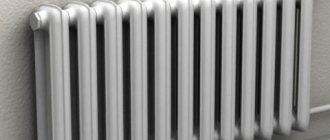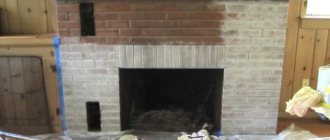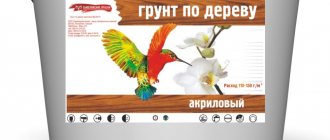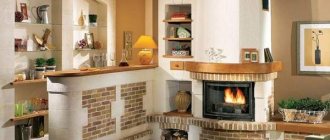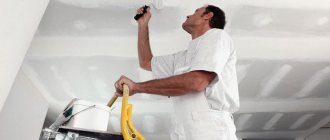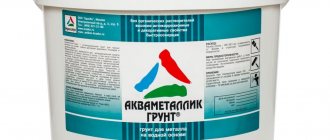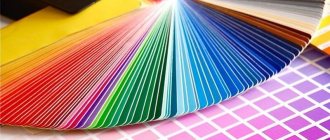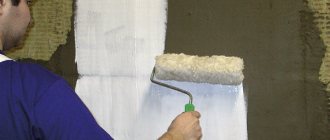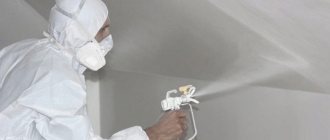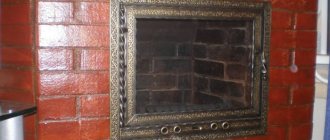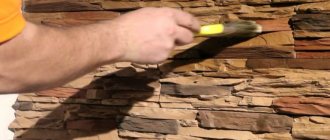Types of popular heat-resistant primers
There are a wide variety of different heat-resistant primers for stoves and fireplaces on the building materials market; let’s look at the most common ones:
- GF-031.
Heat-resistant primer in the form of a suspension consisting of antioxidants. The mixture is used for treating coatings. The most permissible temperature threshold is 200°C. The basis of the soil is a solvent, which is used for diluting properties when it thickens. A similar look is applied as a result of spraying actions. The mass is made in a yellow tint.
- Phosphosoil.
This heat-resistant primer reacts with the coating and creates a thin layer of phosphate that does not dissolve, and as a result, a significant level of adhesion increases, which prevents the formation of corrosive properties on the surface. This tool is based on the following components:
- Phosphoric acid
- Zinc oxide
- Sodium nitrite
- Chromium trioxide
- Alcohol (g/l)
- Water
The composition of this heat-resistant primer includes a mixture of acrylic, formaldehyde and epoxy resins, and is used only outdoors or in industrial applications. The highest temperature tolerance is 300°C. A lot of the product is used not only for working on metal surfaces, but can also be used for finishing fiberglass or ceramics. The product is applied to a surface that has been cleared of contaminants. In addition, it is also applied to rusty parts of the surface. To dilute heat-resistant primer, solvents such as acetone or toluene are often used. The product can also be applied in sub-zero temperatures down to -10°C). The prime advantage of the soil is that it dries very quickly within half an hour. The consumption of heat-resistant product is about 90 g/m2.
Attention! It is better to pre-clean rusty parts of the surface so that layers do not form on the surface layer of the part.
- G-77
Heat-resistant primer intended for stoves and fireplaces is distinguished by its heat resistance. The temperature regime is 1200°C, which is significantly superior to other soils.
Permissible temperatures
Let's consider what are the permissible temperatures for priming the surface. First, let’s find out why we need soil that will heat up during operation.
- To improve coating adhesion.
During application of the primer, there is a surface converter that helps transform the coating into a chemical protection during application.
- To prevent corrosive properties on the surface.
- To reduce the amount of special characteristics absorbed and also to reduce the amount of paint consumed. This treatment is very justified, since the cost is slightly lower than a product of similar quality.
What is the maximum temperature for heat-resistant primer for ovens? Typically, the temperature ranges between 70/50 o C; at such indicators, ordinary finishing materials are used without risk or fear. With the right approach, you don’t have to worry about the possibility of paint delamination or fading.
- Up to 100 o C - you can use ordinary material, but durable pigment paint is suitable.
- Up to 300°C - here you already need a heat-resistant soil that can easily cope with long-term heating and at the same time will retain all its properties at the maximum level of the equipment mode.
- More than 300 o C - materials applied to the equipment do not require the use of primer, since the primer can, on the contrary, cause damage and peeling of the coating cannot be avoided.
Effectiveness of Heat Resistant Surface Primer
Mortar for laying fireplaces and stoves is used for the following purposes:
- To increase the level of adhesion of putty and plaster
- To strengthen the base of the coating
At high operating temperatures, you can forget about the use of gypsum and cement. To decorate the oven, you can use clay and sand.
Permissible temperatures
Primer for heated surfaces
Are you wondering at what maximum temperature a heat-resistant primer is needed? Let's analyze the requirements that are put forward for coatings at different operating temperatures.
- Up to 60oC
As a rule, autonomous heating is installed at this temperature. Their usual temperature fluctuations are 70/50°C, which on the device itself does not exceed the permissible 60°C.
Article on the topic: How to check the operation of a difavtomat?
With this indicator, you can safely use ordinary finishing materials. If repair work is carried out correctly, you don’t have to worry about delamination or fading of paint and varnish materials.
- Up to 100oC
Conventional materials are also suitable for this temperature, but there is one small feature: you need to use paint with a durable pigment. The binder and solution will be the same as at 60°C.
- Up to 300oC
But at such temperatures you already need to think about heat-resistant soil. If the instructions for heat-resistant paints and varnishes indicate the need to apply primer, you will need to rack your brains about purchasing a specialized composition that can easily cope with prolonged heating and will retain its properties when the equipment is heated to maximum.
- More than 300oC
All paints and varnishes that are applied to equipment whose operation occurs at temperatures exceeding 300°C do not require the use of primer. At such an operating temperature, the primer can only aggravate the situation and peeling of the coating cannot be avoided.
Heat Resistant Clay Kiln Primer
The limit threshold for the temperature regime is one thing, but the predominance of substances that pass into the air with increasing temperature is another. After the primer dries, it prevails in the state of a polymer film, volatile substances evaporate during the drying process, and there is no odor. The polymer heats up, retaining its characteristics, then destruction occurs, the film becomes soft, and then cracking and charring occurs. For outdoor work it ranges from minus 40 to plus 50 Celsius. There is no need to worry if the product is in a good range. If you have an ordinary Russian stove, then the temperature will not exceed 70-80 degrees Celsius. Ordinary primers normally predominate. If you spray water, it hisses, which means it’s above 100 degrees, household primers and paints disappear. If it doesn't hiss, the primer and paint will hold up. Check: dry the primer and paint, and then you need to heat the stove.
Temperature standards
Heat-resistant soils have special compositions adapted to strictly defined conditions.
When choosing a product, you need to have an accurate idea of the planned thermal load regime and take an interest in the manufacturers’ recommendations displayed on the labels. Heat-resistant primer is available for use in the following temperature ranges:
- from room temperature to 60 °C;
- no more than 100 °C;
- up to 300 °C;
- more than 300 °C.
Products of the first group are used for water heating systems in apartments or houses; the second - for steam systems, fireplaces, external surfaces of stoves.
For powerful household heaters and industrial installations operated in harsh conditions, soils with higher fire-retardant properties are intended.
Using heat-resistant primers for metal
Pipes are made of steel and heating radiators are made of metal. Significant temperature conditions during operation should not affect the quality characteristics of the surface layer. For this, it is so important to use heat-resistant enamel, paints and, of course, a primer layer. If the surface looks rusty, it can ruin the entire appearance of the product. And after applying the primer, it can significantly improve the appearance: the surface layer will have a smooth and even surface. If you carefully treat the surface layer of the metal, corrosion damage will be reduced.
Attention!
The enamel that will be spent on applying the primer will be greater, so it is necessary to carry out coating treatment. It can improve the adhesive properties after treating the primer layer, which can significantly extend the service life of the coating, and the appearance of the product will be excellent.
Primer for pipes - types, application and processing
Metal pipes are needed everywhere - for installing drains, laying all types of communications, for installing load-bearing structures and much more. Metal is strong, durable and, if used correctly, can last for decades. It has only one drawback: it is defenseless against corrosion.
Many people try to protect pipes by simply painting them with oil paint, but this is not enough, the coating soon begins to peel off, fall off, and the metal surface is again defenseless against environmental aggression. For long-term service of pipes, you need to not just paint them, but carry out a complete treatment with the obligatory application of a primer.
Purposes of priming
Using a primer before painting has several advantages:
- To process iron products, as a rule, compounds with an anti-corrosion effect are used, which can not only level the surface of the pipes as much as possible, ensuring uniform application of paint, but also protect against rust.
- Significant increase in the adhesion strength of the paint coating to the base.
- Reduced construction costs, because when painting steel surfaces after using a primer, much less enamel or varnish is required.
- They are able to compensate for the difference in thermal coefficients inside the pipe and the surrounding atmosphere, giving additional strength to the coating.
Basics of choosing the right soil
When planning to paint and purchasing a primer for metal, you need to consider several important factors.
Purpose of the product
- for central heating radiators - pipes are subject to temperature changes;
- for supplying cold water - the surface of the pipes will always be cold and wet;
- for hot water supply: constantly exposed to high temperatures, surfaces are dry;
- gas;
- outdoors (weather conditions and atmospheric influences should be taken into account);
- in room.
Quality and type of steel
To provide the necessary protection and extend the life of the product, depending on its purpose, mixtures are used:
- Insulating primers. Manufactured based on standard paint compositions (white lead, red lead) with the addition of special additives, for example, an epoxy mixture. When applied, a durable thin film is created on the surface, preventing contact of the product with the atmosphere. Good for outdoor pipes.
- Phosphating type, two-component primers. They are a mixture of active components that enhance the passivation of metal and phosphoric acid, suitable for processing all types of steel pipes, and have high adhesion. They are often used before applying any paint finishes, enhancing their protective properties and reducing paint consumption.
- Passivating coatings change the electrochemical properties, slowing down the formation of corrosion and rust. The chemical properties of the composition protect even if water has penetrated under the applied layer. Good for wet pipes.
- Primer protector is a metal suspension dissolved in a paint base. When dry, it forms a thin metal film and has high protective functions.
- Inhibitors are a new generation of protective primer enamels, made on a water and oil basis, which reliably and effectively protect against corrosion. Suitable for pipes exposed to damp conditions or outdoors.
- Primer-converter (for rust) based on phosphoric acid. The mixture converts iron oxide (rust) into iron phosphate. The result of this chemical reaction is a protective insoluble film that can partially restore the coating corroded.
Content temperature
The temperature of the pipes also plays an important role. It must also be taken into account when choosing the heat resistance of the primer mixture and the subsequent finishing layer:
- Up to 60°C. Typically, this temperature regime is quite sufficient for central heating radiators and hot water pipes. If all processing steps are followed, you can use any general purpose paint-based primer. The paint lies evenly on them, reducing material consumption, does not fade, and does not peel off.
- Up to 100°C. These compositions are best used in private homes, where the owners themselves regulate the heating temperature, and the heating of radiators can exceed 60°C. Regular primer is suitable for this, only the decorative coating should be used with fade-resistant pigments.
- Soil mixtures are also produced that can withstand temperatures above 300°C. Used only in industrial enterprises.
We recommend: Properties and features of the use of primer AK-070
When purchasing the required solution in a store, it is very important to find out the consumption of primer for metal. Usually it is about 100 g per 1 m2.
Subtleties of the processing process
Application of primer to metal pipes and heating radiators occurs in the same way as to other surfaces, but has some features:
- The surface is thoroughly cleaned of old paint and rust until it shines. For this purpose it is better to use metal brushes. When cleaning hard-to-reach areas of heating radiators, you can use metal brushes.
- If a layer of old paint does not come off well, then you need to use a special softening solution, which is applied to pipes and heating radiators and covered with a film. After waiting a little time, excess layers can be easily removed with a spatula.
- After this, the work area must be thoroughly cleaned with sandpaper, gradually changing its grain size to a finer one, and cleaning the metal until shiny and smooth.
- Rinse and let dry.
- Treat dried products with white spirit or any other suitable degreaser and dry.
The next step is to begin applying the primer. Depending on the size of the surface and the composition of the primer mixture, it is applied:
- With a brush. The brush provides a more thorough treatment of uneven surfaces, but on large flat areas (for example, thin long pipes) it takes a long time to work with it and the material consumption is high.
- Rollers of different sizes. The use of small rollers in small areas significantly reduces the consumption of the protective composition.
- With a spray gun.
Priming occurs in several layers. The first is applied very thinly, filling small irregularities and cracks.
After it dries, another 1-3 layers are added if necessary. The primer consumption will decrease with each new layer.
It is advisable to carry out the processing process on products at room temperature. Heating radiators should be turned off temporarily. This will ensure uniform drying, increase the quality of work and reduce primer consumption.
Decorative paint and varnish coatings will lie perfectly smoothly on the surface treated in this way, without drips or streaks, providing the pipe with additional protection from moisture and temperature changes and significantly extending its service life. If you take the time and correctly carry out all the processing steps before painting, then the plumbing and heating systems will not require replacement for a long time.
Primer for pipes is a mandatory processing step, which allows the future coating to be well fixed and to provide protection against corrosion. The primer is chosen depending on the purpose of the pipe, be it a radiator or a gas pipeline.
Classification of heat-resistant soil depending on temperature resistance
Material properties.
The composition is used to strengthen the base of an object and prepare it for coating with materials with different physical properties (density, viscosity). A primer with heat-resistant properties is used in the same way as a regular one, but their compositions differ.
The regular one contains resins, glue, oil, and the heat-resistant one contains special acrylic and polymer components that are resistant to temperature.
The use of a heat-resistant composition will provide a smooth coating, which is then perfect for applying finishing material.
High-temperature material will perfectly save building materials. In addition, it creates conditions for excellent adhesion of the object to the finish (for example, a fireplace with plaster).
Without it, cracks may soon form on the finishing surface due to differences in heat capacity.
Application of heat-resistant composition for metal objects. For metal objects (radiator and heating boiler), which tend to heat up during operation, it is necessary to use heat-resistant materials (paints, enamels, primer).
Applying enamel without a special primer is not recommended, since a rusty, unfinished surface loses its aesthetic appearance. The use of a high-temperature composition will combine rust and dust, thereby making the surface smooth.
In addition, it should be noted that the consumption of expensive enamel without the use of primer will increase significantly. Enamel improves adhesive properties to metal after coating with primer, and this will increase the service life of the surface and give an acceptable aesthetic appearance.
When using the product, corrosion and oxide stains will not appear on metal objects being processed. Mechanism of action of the composition.
Heat-resistant primer turns rust and oxide film into a strong, reliable surface that will be resistant to high temperatures without affecting the properties of the materials.
Enamel is then applied to this coating. Moreover, if you cover metal objects only with a primer, you can get a smooth, attractive and reliable surface, caring for which will not be any hassle at all.
Also, the primer, as a middle layer, will balance thermal expansion between surfaces.
Liquid absorption is reduced, thereby increasing the service life of enamel and other finishes. This is especially important for brick stoves and fireplaces, which absorb condensation and moisture around them.
Thus, the use of a primer with heat-resistant properties is quite reasonable due to its low price, in contrast to expensive heat-resistant enamels.
Classification depending on temperature resistance. Depending on the resistance to temperature, the product is divided in a certain way.
When exposed to a given temperature, the composition does not change its characteristics and properties.
Tags: thermal paint, heat-resistant paint
Comments 87
I used Certa and liked it. It lays down well, there were no detachments or anything else, we’ll see how it goes over time, but in general it’s written that it should last up to 25 years.
The recordings are already a year old)) But I also stopped at the concert, the price/quality is simply unparalleled
I used KUDO. They wrote correctly, my buddy stole 3 different malas, only after that I read the instructions. They also have alkyd, acrylic, etc. Everything needs to be clearly applied there, some types right away, others, on the contrary, later. Read instructions and recommendations. And about Kudo, a normal company, normal products, no worse or better than others. And worth the money.
When purchasing thermal paint, pay attention to the temperature table...
I used Motip brake caliper spray for calipers almost half a year ago, it’s holding up.
Bosny is fierce shit)
Clean the calipers using electrolysis in a caustic solution and leave it like that, the paint reduces heat transfer
If the caliper is not covered, it will rust very quickly after electrolysis. Yes, paint reduces heat transfer, but this % is already included in the brakes because All brakes are painted from the factory
If so, then I agree
If the caliper is not covered, it will rust very quickly after electrolysis. Yes, paint reduces heat transfer, but this % is already included in the brakes because All brakes are painted from the factory
This is about heat transfer, no need for misconceptions... Camping flask or Kirchhoff's law
+1 interesting channel
Don’t use it for stoves and chimneys, we’ve already done it. If you’re interested in my choice, read here www.drive2.ru/l/7460004/
Paint with good acrylic. based on experience of painting boxer engines with paints. heat-resistant was washed off. but acrylic still holds up
The heat-resistant Kudo has been running on swinishly prepared calipers (I just went through it with a hand brush and blew it out, didn’t degrease it) since the fall. I’m surprised, but it’s a fact.
